#Kanin Stanley
Explore tagged Tumblr posts
Text












I truly understand and never wish to stop you.
THE LOYAL PIN | EP.10
#I'm rewatching it and I find myself more and more impressed with the delicacy and care with which this series portrays Anil and Pin's love#as well as all the care and family love around Anil and who she is#they never try to prune her or change her especially Anan#they simply love her and accept her exactly as she is#huge ass post but i dont care this scene is so precious#and prince anan is even more precious#I'll go to the trenches for him#the loyal pin#Rebecca Armstrong#Becky Armstrong#princess anil#prince anan#Kanin Stanley#Ohm Kanin Stanley#thai gl#gifs — mine#pinpak
145 notes
·
View notes
Text
Top two vote-getters will move on to the next round. See pinned post for all groups!
#best best screenplay tournament#oscars#academy awards#best original screenplay#chinatown#robert towne#woman of the year#ring lardner jr.#michael kanin#almost famous#cameron crowe#pillow talk#stanley shapiro#maurice richlin#clarence greene#russell rouse#juno#diablo cody#bracket tournament#brackets#poll#polls
1 note
·
View note
Text
สะใภ้เจ้าสัว Sapai Jao Sua I Ohm, Prim
Title: สะใภ้เจ้าสัว / Sapai Jao Sua Also known as: Chinese Tycoon’s Daughter-in-Law / Daughter-in-War Duration: 28 Episodes Genre: Drama/Romance/Comedy Popularity: top rated/low rated/failure Air time: Monday-Friday Broadcast network: Channel 3 Broadcast period: April 7, 2021 — May 14, 2021 Company Name: D One TV Cast Ohm Kanin Stanley as Traiwit Prim Prima Bhunjaroeun as Fahsai Singto Sakolrat…

View On WordPress
1 note
·
View note
Photo

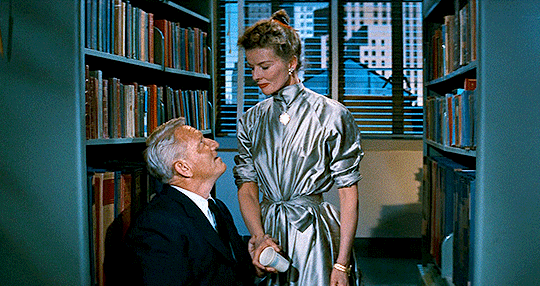

DESK SET (1957) THE SPENCER TRACY LEGACY: A TRIBUTE BY KATHARINE HEPBURN (1986)
Dear Spence—who ever thought that I’d be writing you a letter. You died on the 10th of June in 1967. My golly, Spence, that’s fifteen, no that's eighteen years ago. That’s a long time. Are you happy finally? Is it a nice long rest you’re having? Making up for all your tossing and turning in life. You know, I never believed you when you said that you just couldn’t get to sleep. I thought, Oh—come on—you sleep—if you didn’t sleep you’d be dead. You’d be so worn out. Then remember that night when—oh, I don’t know, you felt so disturbed. And I said, Well, go on in—go to bed. And I’ll lie on the floor and talk you to sleep. I’ll just talk and talk and you’ll be so bored, you’re bound to drift off. Well, I went in and got an old pillow and Lobo the dog. I lay there watching you and stroking Old Dog. I was talking about you and the movie we’d just finished—Guess Who’s Coming to Dinner—and my studio and your new tweed coat and the garden and all the nice sleep-making topics and cooking and dull gossip, but you never stopped tossing—to the right, to the left—shove the pillows—pull the covers—on and on and on. Finally—really finally—not just then—you quieted down. I waited a while—and then I crept out. You told me the truth, didn’t you, Spence? You really could not sleep. And I used to wonder then—why? Why, Spence? I still wonder. You took the pills. They were quite strong. I suppose you have to say that otherwise you would never have slept at all. Living wasn’t easy for you, was it? What did you like to do? You loved sailing, especially in stormy weather. You loved polo. But then Will Rogers was killed in that airplane accident. And the fun went out of it for you, didn't it? You never played polo again—never again. Tennis, golf, swimming, no, not really. You’d bat a few balls. Fair you were. I don’t think that you ever swang a golf club. Is “swang” a word? Swimming? Well, you didn’t like cold water. And walking? No, that didn’t suit you. That was one of those things where you could think at the same time—of this, of that, of what, Spence? What was it? Was it some specific life thing like Johnny being deaf, or being a Catholic and you felt a bad Catholic? No comfort, no comfort. I remember Father Ciklic telling you that you concentrated on all the bad and none of the good which your religion offered. It must have been something very fundamental, very ever-present. And the incredible fact. There you were—really the greatest movie actor. I say this because I believe it and I have heard many people of standing in our business say it. From Olivier to Lee Strasberg to David Lean. You name it. You could do it. And you could do it with that glorious simplicity, that directness: you could just do it. You couldn’t enter your own life, but you could be someone else. You were a killer, a priest, a fisherman, a sportswriter, a judge, a newspaperman. You were it in a moment. You hardly had to study. You learned the lines in no time. What a relief! You could be someone else for a while. You weren’t you—you were safe. You loved to laugh, didn’t you? You never missed those individual comics: Jimmy Durante, Phil Silvers, Fanny Brice, Frank McHugh, Mickey Rooney, Jack Benny, Burns and Allen, Smith and Dale, and your favorite, Bert Williams. Funny stories: you could tell them—and brilliantly. You could laugh at yourself. You enjoyed very, very much the friendship and admiration of people like the Kanins, Frank Sinatra, Bogie and Betty, George Cukor, Vic Fleming, Stanley Kramer, the Kennedys, Harry Truman, Lew Douglas. You were fun with them, you had fun with them, you felt safe with them. But then back to life’s trials. Oh hell, take a drink—no-yes-maybe. Then stop taking the drink. You were great at that, Spence. You could just stop. How I respected you for that. Very unusual. Well, you said on this subject: never safe until you’re seven feet underground. But why the escape hatch? Why was it always opened—to get away from the remarkable you? What was it, Spence? What was it? I meant to ask you. Did you know what it was? What did you say? I can’t hear you. . .
#oldhollywoodedit#classicfilmedit#filmedit#film#mygifs*#deskset*#spencer tracy#katharine hepburn#i think about this every single day of my entire life#from the bottom of my heart i love them most of all#parallels
702 notes
·
View notes
Text
Favorite Movies About Hollywood

Below is a list of my favorite movies about Hollywood (in chronological order):

1. “Bombshell” (1933) - Victor Fleming directed this excellent comedy about a Hollywood starlet struggling to change her sexy image, despite the scheming of her manipulative publicist. Jean Harlow and Lee Tracy starred.
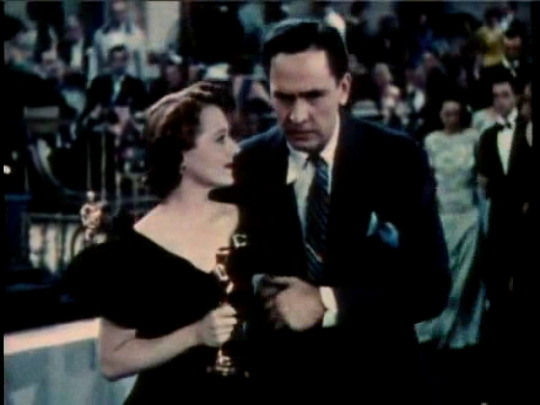
2. “A Star Is Born” (1937) - William Wellman directed the first of four versions of a tale about an aspiring Hollywood actress and her relationship with an actor whose career and fame is fading. Janet Gaynor and Fredric March starred.

3. “Sunset Boulevard” (1950) - Billy Wilder directed and co-wrote with Charles Brackett this fascinating tale about a struggling screenwriter who develops a dangerous relationship with a faded film star determined to make a triumphant return. William Holden and Gloria Swanson starred.

4. “Singin’ in the Rain” (1952) - Gene Kelly and Stanley Donen directed this delightful and funny musical about the depiction of a Hollywood studio as it experiences the transition from silent to talking films during the late 1920s. Kelly starred with Donald O’Connor and Debbie Reynolds.
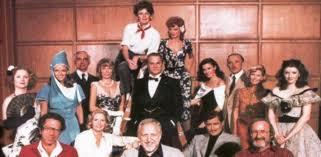
5. “The Scarlett O’Hara War” (1980) - Tony Curtis starred as producer David O. Selznick in this adaptation of Garson Kanin’s 1979 novel, “Moviola”. The movie focused on Selznick’s search for the right actress to play Scarlett O'Hara in the much anticipated film adaptation of “Gone with the Wind”. John Erman directed.
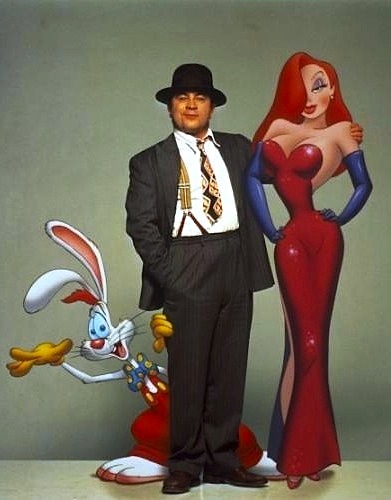
6. “Who Framed Roger Rabbit?” (1988) - Robert Zemeckis directed this excellent but loose adaptation of Gary K. Wolf’s 1981 novel, “Who Censored Roger Rabbit?”. The movie starred Bob Hoskins, Charles Fleischer, Kathleen Turner and Christopher Lloyd.

7. “The Rocketeer” (1991) - Joe Johnston directed this adaptation of Dave Stevens’ comic book series about a stunt pilot who stumbles across a prototype jetpack that allows him to become a high-flying masked hero in 1938 Los Angeles. Bill Campbell, Jennifer Connolly, Alan Arkin and Timothy Dalton starred.

8. “Get Shorty” (1995) - Barry Sonnenfeld directed this excellent adaptation of Elmore Leonard’s 1990 novel about a Miami loan shark who becomes involved in the movie business during a trip to Los Angeles. John Travolta, Rene Russo and Gene Hackman starred.

9. “Bowfinger” (1999) - Frank Oz directed this hilarious movie about a down-and-out filmmaker in Hollywood attempting to make a film on a small budget with a star who does not know that he is in the film. Steve Martin and Eddie Murphy starred.
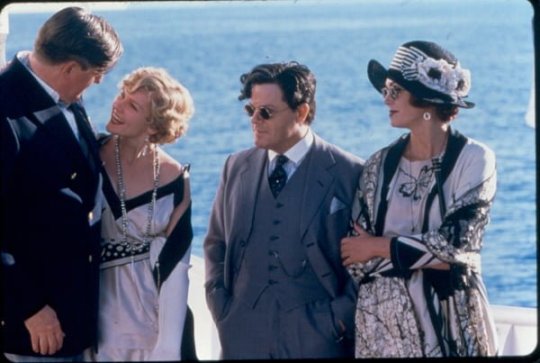
10. “The Cat’s Meow” (2001) - Peter Bogdanovich directed this fictionalized account of William Randolph Hearst’s November 1924 weekend cruise celebrating Thomas Ince’s birthday. The movie starred Kirsten Dunst, Edward Hermann, Eddie Izzard and Cary Elwes.
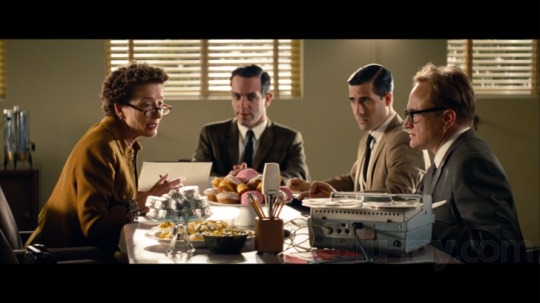
11. “Saving Mr. Banks” (2013) - John Lee Hancock directed this superb and emotional tale about author P.L. Travers and producer Walt Disney’s tug-of-war over the development of the 1964 movie, "Mary Poppins". Emma Thompson and Tom Hanks starred.

12. “Once Upon a Time . . . in Hollywood” (2019) - Quentin Tarantino wrote and directed this excellent tale about a fading actor and his stunt double struggling to regain success in the film industry during the final year of Hollywood’s Golden Age in 1969 Los Angeles. Oscar nominee Leonardo Di Caprio, Oscar winner Brad Pitt and Oscar nominee Margot Robbie starred.
#movies about hollywood#old hollywood#bombshell 1933#jean harlow#lee tracy#victor fleming#a star is born 1937#william wellman#janet gaynor#fredric march#sunset boulevard#sunset boulevard 1950#Billy Wilder#charles brackett#william holden#gloria swanson#Singin' in the Rain#gene kelly#stanley donen#donald o'connor#debbie reynolds#the scarlett o'hara war#gwtw#tony curtis#john erman#who framed roger rabbit#robert zemeckis#bob hoskins#charles fleischer#kathleen turner
14 notes
·
View notes
Text


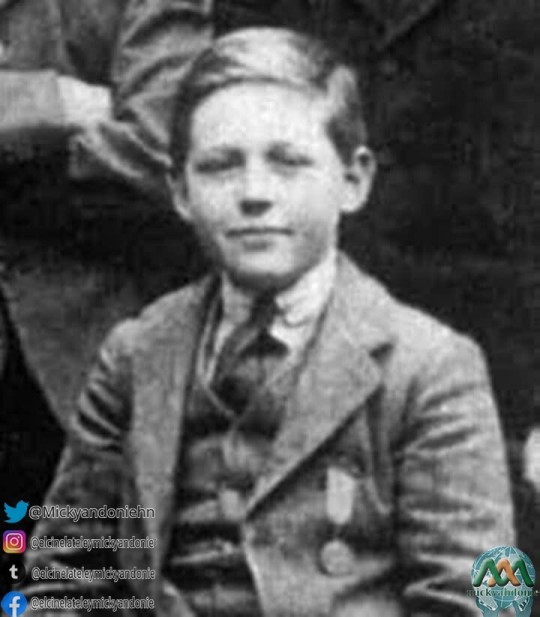
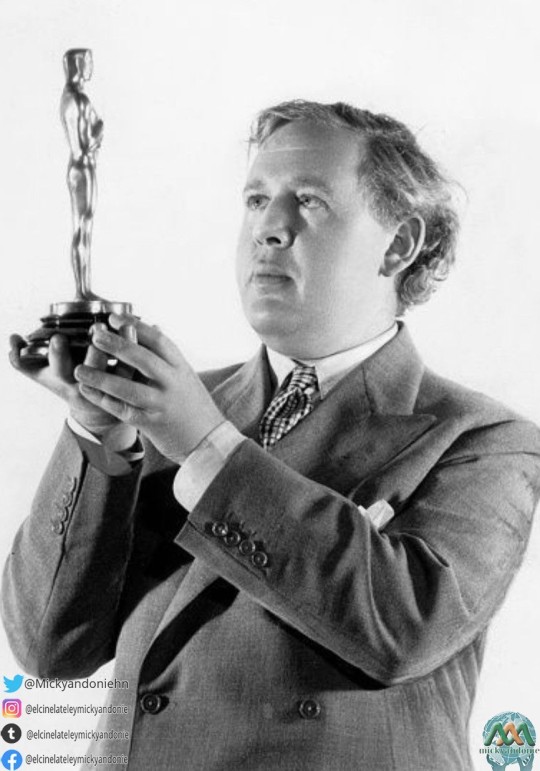
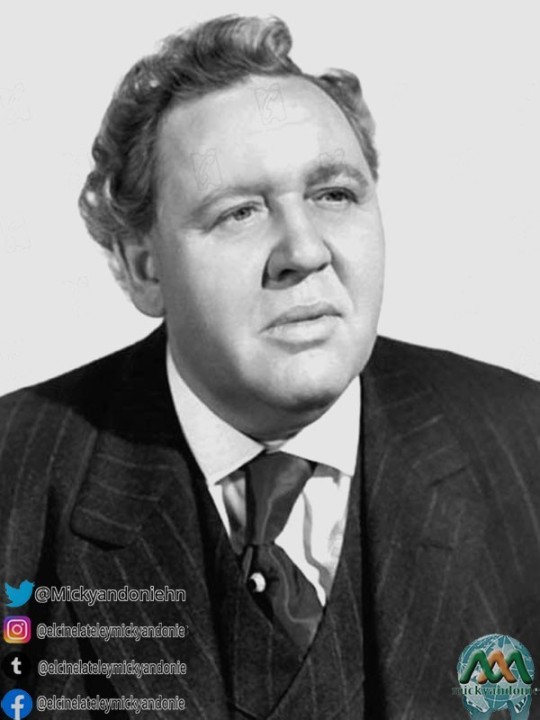
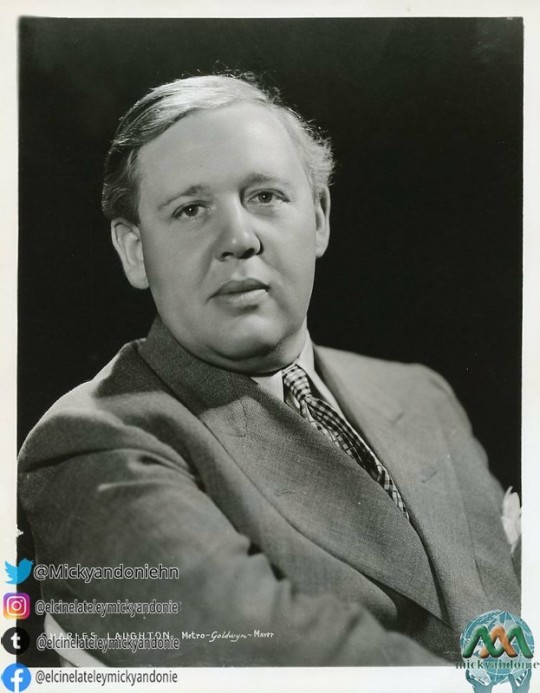

Charles Laughton.
Filmografía
Películas
- Bluebottles, The Tonic, Daydreams (1928) Dir.: Ivor Montagu
- Piccadilly (1929) Dir.: Ewald Andrea Dupont.
- Wolves (1930).
- Down River (1931) Dir. Peter Godfrey
-El caserón de las sombras (The Old Dark - House, 1932) Dir. James Whale
- Entre la espada y la pared (The Devil and the Deep, 1932) Dir. Marion Gering
- Justicia divina/El asesino de Mr. Medland (Payment Deferred, 1932) Dir. Lothar Mendes
- El signo de la cruz (The Sign of the Cross, 1932) Dir. Cecil B. De Mille
- Si yo tuviera un millón (If I Had a Million, 1932) Dirs. Ernst Lubitsch, Norman Taurog, Stephen Roberts, Norman McLeod, James Cruse, William A. - Seiter y H. Bruce Humberstone
- La isla de las almas perdidas (Island of Lost Souls, 1932) Dir. Erle C. Kenton
- La vida privada de Enrique VIII (The Private Life of Henry VIII, 1933) Dir. Alexander Korda
- White Woman (1933) Dir. Stuart Walker
- The Barretts of Wimpole Street (1934) Dir. Sidney Franklin
- Nobleza obliga (Ruggles of Red Gap, 1935) Dir. Leo McCarey
- Los miserables (Les Misérables, 1935) Dir. Richard Boleslawsky
- Rebelión a bordo (Mutiny on the Bounty, 1935) Dir. Frank Lloyd
- Rembrandt (Rembrandt, 1936) Dir. Alexander Korda
- Yo, Claudio (I, Claudius, 1937) Dir. Joseph von Sternberg.
- Bandera amarilla (Vessel of Wrath, 1938) Dir. Eric Pommer (Laughton es actor y coproductor de esta película).
- Las calles de Londres (St. Martin's Lane, 1938) Dir. Tim Whelan (Laughton es actor y coproductor de esta película).
- La posada de Jamaica (Jamaica Inn, 1939) Dir. Alfred Hitchcock (Laughton es actor y coproductor de esta película).
- Esmeralda, la zíngara (The Hunchback of Notre Dame, 1939) Dir. William Dieterle
- Laughton en la película Ellos sabían lo que querían (1940), con Carole Lombard y Frank Fay.
- They Knew What They Wanted (1940) Dir. Garson Kanin
- Casi un ángel (It Started with Eve, 1941) Dir. Henry Koster
- Se acabó la gasolina (The Tuttles of Tahiti, 1942) Dir. Charles Vidor
- Seis destinos (Tales of Manhattan, 1942) Dir. Julien Duvivier
- Stand by for Action (1943) Dir. Robert Z. Leonard
- Forever and a Day (1943) Dirs. René Clair, Edmund Goulding, Cedric Hardwicke, Frank Lloyd, Victor Saville.
-Esta tierra es mía (This Land Is Mine, 1943) Dir. Jean Renoir
- The Man from Down Under (1943) Dir. Robert Z. Leonard
- The Canterville Ghost (1944) Dir. Jules Dassin
- El sospechoso (The Suspect, 1944) Dir. Robert Siodmak
- El capitán Kidd (Captain Kidd, 1945) Dir. Rowland V. Lee
- Su primera noche (Because of Him, 1946) Dir. Richard Wallace
- Arco de triunfo (Arch of Triumph, 1947) Dir. Lewis Milestone
- El reloj asesino (The Big Clock, 1947) Dir. John Farrow
- El proceso Paradine (The Paradine Case, 1948) Dir. Alfred Hitchcock
- On our Merry way/A Miracle can Happen (1948) Dirs. King Vidor, Leslie Fenton, John Huston, George Stevens.
- The Girl from Manhattan (1948) Alfred E. Green
- Soborno (The Bribe, 1949) Dir. Robert Z. Leonard
- El hombre de la torre Eiffel (The Man on the Eiffel Tower, 1949) Dir. Burgess Meredith (codirectores no acreditados: Charles Laughton y Franchot Tone).
- No estoy sola (The Blue Veil, 1951) Dir. Curtis Bernhardt
- The Strange Door (1951) Dir. Joseph Pevney
- Cuatro páginas de la vida (O. Henry's Full House, 1952) Dir. Henry Koster
- Abbott and Costello Meet Captain Kidd (1952) Dir. Charles Lamont
- Salomé (Salome, 1953) Dir. William Dieterle
- La reina virgen (Young Bess, 1953) Dir. George Sidney
- El déspota (Hobson's Choice, 1954) Dir. David Lean
- La noche del cazador (The Night of the Hunter, 1954) Dir. Charles Laughton (no aparece como actor en la película).
T- estigo de cargo (Witness for the Prosecution, 1957) Dir. Billy Wilder
- Bajo diez banderas (Sotto dieci bandiere, 1960) Dir. Diulio Colletti
Espartaco (Spartacus, 1960) Dir, Stanley Kubrick
- Tempestad sobre Washington (Advise and Consent, 1962) Dir. Otto Preminger.
Documentales
- The Epic That Never Was (1965). Dirigido por Bill Duncalf y presentado por Dirk Bogarde. Documental de la BBC sobre el rodaje de I, Claudius con diversas escenas acabadas. (VHS, DVD).
- Callow's Laughton (1987). Documental de la Yorkshire TV-ITV dirigido por Nick Gray y presentado por Simon Callow sobre Charles Laughton.
- Charles Laughton Directs The Night of the Hunter (2002). Documental dirigido por Robert Gitt a partir de tomas descartadas de la Película.
Teatro
Debut teatral (1913). Stonyhurst College, Reino Unido
- The Private Secretary per Charles Hawtrey
Teatro amateur (hasta 1925). Scarborough, Reino Unido
- The Dear Departed por Stanley Houghton
- Trelawney of The Wells por Arthur Wing Pinero
- Hobson's Choice por Harold Brighouse
1926
- The Government Inspector. por Nicolai Gogol. Dir. Theodore Komisarjevsky
- Los puntales de la sociedad por Henrik Ibsen. Dir. Sybil Arundale
- El jardín de los cerezos por Antón Chéjov. Dir. Theodore Komisarjevsky
- Las tres hermanas por Antón Chéjov. Dir. Theodore Komisarjevsky
- Liliom por Ferencz Molnar. Dir. Theodore Komisarjevsky
1927
- The Greater Love por James B. Fagan. Dir. James B. Fagan y Lewis Casson
- Angela por Lady Bell. Dir. Lewis Casson
Vestire gli ignudi por Luigi Pirandello. Dir. Theodore Komisarjevsky
- Medea por Eurípides. Dir. Lewis Casson
- The Happy Husband por Harrison Owen. Dir. Basil Dean
- Paul Y por Dimitri Merejovski. Dir. Theodore Komisarjevsky
- Mr. Prohack por Arnold Bennet y Edward Knoblock. Dir. Theodore Komisarjevsky
1928
- A Man with Red Hair por Benn W. Levy, a partir de la novela de Hugh Walpole. Dir. Theodore Komisarjevsky
- The Making of an Immortal por George Moore. Dir. Robert Atkins
- Riverside Nights por Nigel Playfair y A.P. Herbert. Dir. Nigel Playfair
- Alibi per Michael Morton, a partir de la novela de Agatha Christie. Dir. Gerald duMaurier
- Mr. Pickwick por Cosmo Hamilton y Frank C. Reilly, a partir de la novela de Charles Dickens. Dir. Basil Dean
1929
- Beauty por Jacques Deval (adapt. inglesa: Michael Morton). Dir. Felix Edwardes
- The Silver Tassie por Sean O'Casey. Dir. Raymond Massey
1930
- French Leave por Reginald Berkeley. Dir. Eille Norwood
- On the Spot por Edgar Wallace. Dir. Edgar Wallace
1930
- Payment Deferred por Jeffrey Dell, a partir de la novela de C.S. Forrester. Dir. H.K. Ailiff
1931
-Gira americana (Chicago y Nueva York) de Payment Deferred y Alibi (esta última retítulada The Fatal Alibi y dirigida por Jed Harris).
Old Vic: temporada 1933-34. Londres. Reino Unido. Todas las obras dirigidas por Tyrone Guthrie.
El jardín de los cerezos por Antón Chéjov. Dir. Charles Laughton
1951-52 Estados Unidos y Reino Unido (Gira).
Don Juan in Hell de Man and Superman por George Bernard Shaw. Dir. Charles Laughton.
1953 Estados Unidos (Gira).
John Brown's Body por Stephen Vincent Benet. Dir. y Adaptación: Charles Laughton (no apareció como actor).
1954 Estados Unidos (Gira).
The Caine Mutiny Court Martial por Herman Wouk, a partir de su novela. Dir. Charles Laughton (no apareció como actor).
1956 Nueva York, Estados Unidos.
Major Barbara por George Bernard Shaw. Dir. Charles Laughton
1956 Londres, Reino Unido
The Party por Jane Arden. Dir. Charles Laughton
1959 Stratford-upon-Avon, Reino Unido
El sueño de una noche de verano por William Shakespeare. Dir. Peter Hall
El rey Lear por William Shakespeare. Dir. Glen Byam Shaw.
Créditos: Tomado de Wikipedia
https://es.wikipedia.org/wiki/Charles_Laughton
#HONDURASQUEDATEENCASA
#ELCINELATELEYMICKYANDONIE
4 notes
·
View notes
Text
Zannah’s Top 50 Films Rec List
Hello everyone! As some of you may know, I have a lot of experience in the world of cinema. Not only do I love it passionately as a hobby, but professionally as well. I’ve seen a lot of movies in my day, both studying them for my degrees and just for fun. Here are some movies that I recommend, if you’re looking to pass the time during this period of isolation and stress. I believe movies are a wonderful way to let out cathartic energy, to feel something, and to escape from the real world for a while.
This is however, not a full list of recommendations, I was just trying to think of things that may be easily accessible for us all in these trying times. If you’d like another list of more obscure films, I’d be happy to put that together as well. But for this post, I thought I’d stick to what I consider to be, ‘the classics’
I’ve got a mix of comedies, dramas, tear-jerkers, uplifting films, horror films, documentaries and musicals. I hope that somewhere among them is something you may have not yet seen, or maybe something you’d like to see again.
Films are alphabetized, not ranked in any particular order of preference :) xxx
Airplane! (1980) dir. David Zucker, Jim Abrahams, Jerry Zucker
Amadeus (1984) dir. Miloš Forman
A Serious Man (2009) dir. The Coen Brothers
BlackKklansman (2018) dir. Spike Lee
Cinderella (1950) dir. Clyde Geronimi, Wilfred Jackson, Hamilton Luske
Do The Right Thing (1989) dir. Spike Lee
Dreams (1990) dir. Akira Kurosawa
F For Fake (1973) dir. Orson Welles
Fiddler on the Roof (1971) dir. Norman Jewison
Footlight Parade (1933) dir. Busby Berkeley, Lloyd Bacon
Funny Girl (1968) dir. William Wyler
Grey Gardens (1975) dir. The Maysles Brothers
Goodfellas (1990) dir. Martin Scorsese
Good Will Hunting (1997) dir. Gus Van Sant
Hairspray (2007) dir. Adam Shankman
Harlon County, USA (1976) dir. Barbara Kopple
His Girl Friday (1940) dir. Howard Hawks
Holes (2013) Andrew Davis
Kramer vs Kramer (1979) dir. Robert Benton
Lars and The Real Girl (2007) dir. Craig Gillespie
Life of Pi (2012) dir. Ang Lee
Little Shop of Horrors (1986) dir. Frank Oz
Love Story (1970) dir. Arthur Hiller
Milk (2008) dir. Gus Van Sant
Moonlight (2016) dir. Barry Jenkins
My Favorite Wife (1940) dir. Garson Kanin
Parasite (2019) dir. Bong Joon-ho
Paris is Burning (1990) dir. Jennie Livingston
Pride & Prejudice (2005) dir. Joe Wright
Raiders of the Lost Ark (1981) dir. Steven Spielberg
Rocky (1976) dir. John G. Avildsen
Roma (2018) dir. Alfonso Cuaron
Seven Samurai (1954) dir. Akira Kurosawa
The 400 Blows (1959) dir. Francois Truffaut
The Color Purple (1985) dir. Steven Spielberg
The Favourite (2018) dir. Yorgos Lanthimos
The Godfather Series
The Invisible Man (1933) dir. James Whale
The Last Samurai (2003) dir. Edward Zwick
The Life Aquatic with Steve Zissou (2004) dir. Wes Anderson
The Life of Brian (1979) dir. Terry Jones
The Shape of Water (2017) dir. Guillermo del Toro
The Shawshank Redemption (1994) dir. Frank Darabont
The Shining (1980) dir. Stanley Kubrick
Thelma and Louise (1991) dir. Ridley Scott
This is Spinal Tap (1984) dir. Rob Reiner
Top Hat (1935) dir. Mark Sandrich
West Side Story (1961) dir. Jerome Robbins, Robert Wise
Yentl (1983) dir. Barbra Streisand
Young Frankenstein (1974) dir. Mel Brooks
36 notes
·
View notes
Text
The first image that comes to mind when I think of Cary Grant is the classy gentleman that ultimately became his signature style. Most brilliant of all in Grant’s impressive repertoire perhaps was his ability to add the bumbling to the suave sophisticate. That’s the man I adore, but that man didn’t come about easily. It was hard work and perseverance that led to the archetype that’s still recognized as the domain of just one man. One.
Cary Grant was born Archibald Leach in Bristol, England on January 18, 1904. From 1932 to 1966 he appeared in over 70 motion pictures becoming one of the greatest movie stars in the world. Ever. And that’s not an exaggeration as you well know. Beloved and admired by the masses and his peers Grant mastered various film genres turning in memorable performances in broad comedies, murder mysteries, adventure stories and romances.
On that road to becoming Cary Grant the image, Cary Grant the actor played men with numerous careers and from different walks of life. It’s quite the impressive resume, one that goes well beyond a gorgeous exterior. Why don’t I show you?
The Cary Grant Résumé
Cary Grant
1 Handsome Movie Star Way, Hollywood, CA 01184 – (000) 227-9472 – [email protected]
Summary:
At least twelve rich, playboy types if you don’t include the five successful businessmen.
Ten soldiers
Six newspaper men/writers
Six doctors/scientists
Five artistic types
Four government agents
Three pilots
Three advertising executives
Two supernatural beings
One Earl, a policeman, an engineer, a lawyer, an economist, a politician, a few unsavory types, half a dozen or so times involved in espionage.
The handsome, rich bachelor often, but was also a loving husband and father to several women and numerous children
Highlights:
Hard-working and reliable
Energetic, well-executed pratfalls
Distinctive double-take
Proficient at fast-talk
Style Icon
Unique voice
Exceptional romantic skills
Great with pets and children
*Experience:
Rich men and playboys (1932 to 1962)
Philip Shayne in Delbert Mann’s That Touch of Mink (1962)
Johnnie Aysgarth in Alfred Hitchcock’s Suspicion (1941)
C. K. Dexter Haven in George Cukor’s The Philadelphia Story (1940)
Alec Walker in John Cromwell’s In Name Only (1939)
Jerry Warriner in Leo McCarey’s The Awful Truth (1937)
Ernest Bliss in Alfred Zeisler’s The Amazing Adventure (1936)
Gerald Fitzgerald in Elliott Nugent’s Enter Madame! (1935)
Jack Clayton in Wesley Ruggles’ I’m No Angel (1933)
Jeffrey Baxter in Paul Sloane’s The Woman Accused (1933)
Romer Sheffield in William Seiter’s Hot Saturday (1932)
Charlie Baxter in Dorothy Arzner’s Merrily We Go to Hell (1932)
Ridgeway in Alexander Hall’s Sinners in the Sun (1932)
This slideshow requires JavaScript.
Businessman (1934 to 1966)
Sir William Rutland in Charles Walters’ Walk Don’t Run (1966)
(and widower) Tom Winters in Melville Shavelson’s Houseboat (1958)
Clemson Reade in Sidney Sheldon’s Dream Wife (1953)
Julian De Lussac in Frank Tuttle’s Ladies Should Listen (1934)
Malcolm Trevor in Lowell Sherman’s Born to be Bad (1934)
PS – If you’re thinking that Cary Grant as business man looks very similar to Cary Grant rich playboy – well, yeah.
Men of science (1934 to 1951)
Physician, Dr. Noah Praetorius in Joseph L. Mankiewicz’s People Will Talk (1951)
Chemist, Dr. Barnaby Fulton in Howard Hawks’ Monkey Business (1952)
Neurosurgeon, Dr. Eugene Norland Ferguson in Richard Brooks’ Crisis (1950)
Pediatrician, Dr. Madison Brown in Don Hartman’s Every Girl Should Be Married (1948)
Paleontologist, David Huxley in Howard Hawks’ Bringing Up Baby (1938)
Plastic Surgeon, Dr. Maurice Lamar in Harlan Thompson’s Kiss and Make-Up (1934)
Soldiers (1932 to 1959)
Lt. Cmdr. Matt T. Sherman in Blake Edwards’ Operation Petticoat (1959)
Cmdr. Andy Crewson in Stanley Donen’s Kiss Them for Me (1957)
Anthony in Stanley Kramer’s The Pride and the Passion (1957)
Captain Henri Rochard in Howard Hawks’ I Was a Male War Bride (1949)
Captain Cassidy in Delmer Daves’ Destination Tokyo (1943)
Sergeant Cutter in George Stevens’ Gunga Din (1939)
Captain Andre Charville in George Fitzmaurice’s Suzy (1936)
British Officer, Micahel Andrews in Charles Barton’s and Louis J. Gasnier’s The Last Outpost (1935)
Lietenant B. F. Pinkerton in Marion Gering’s Madame Butterfly (1932)
Lt. Jaeckel (naval officer) in Marion Gering’s Devil and the Deep (1932)
This slideshow requires JavaScript.
Writers and newspaper men (1934 to 1944)
Mortimer Brewster in Frank Capra’s Arsenic and Old Lace (1944)
Reporter, Roger Adams in George Stevens’ Penny Serenade (1941)
Patrick “Pat” O’Toole in Leo McCarey’s Once Upon a Honeymoon (1942)
Walter Burns in Howard Hawks’ His Girl Friday (1940)
Reporter Charlie Mason in Richard Wallace’s Wedding Present (1936)
Newspaper publisher, Porter Madison III in Marion Gering’s Thirty Day Princess (1934)
Spies or government agents (1933 to 1964)
Including this one because it borders on “spying” – Walter in Ralph Nelson’s Father Goose (1964)
Peter Joshua in Stanley Donen’s Charade (1963)
Devlin in Alfred Hitchcock’s Notorious (1946)
Captain Cummings in Lowell Sherman’s She Done Him Wrong (1933)
Con men, grifters, a thief and a politician (1932 to 1955)
Retired Cat Burglar in Alfred Hitchcock’s To Catch a Thief (1955)
Gambler and grifter, Joe “the Greek” Adams in H. C. Potter’s Mr. Lucky (1943)
Con man, Nick Boyd in Rowland V. Lee’s The Toast of New York (1937)
Con man, adventurer, Jimmy Monkley in George Cukor’s Sylvia Scarlett (1935)
Gambler, Ace Corbin in Louis J. Gasnier’s and Max Marcin’s Gambling Ship (1933)
Nick Townsend in Josef von Sternberg’s Blonde Venus (1932)
Pilots (1933 to 1939)
Geoff Carter in Howard Hawks’ Only Angels Have Wings (1939)
Ken Gordon in James Flood’s Wings in the Dark (1935)
Henry Crocker in Stuart Walker’s The Eagle and the Hawk (1933)
Men of the arts (1937 to 1957)
Nickie Ferrante in Leo McCarey’s An Affair to Remember (1957)
Dick Nugent in Irving Reis’ The Bachelor and the Bobby-Soxer (1947)
Cole Porter in Michael Curtiz’s Night and Day (1946)
(Crooked) Showman Jerry Flynn in Alexander Hall’s Once Upon a Time (1944)
Jimmy Hudson in Robert Riskin’s When You’re in Love (1937)
Drifters, activists, miscellaneous fellows or regular Joes (1932 to 1944)
Ernie Mott in Clifford Odets’ None But the Lonely Heart (1944)
Mill worker and activist, Luopold Dilg in George Stevens’ The Talk of the Town (1942)
Farmer, Matt Howard in Frank Loyd’s The Howards of Virginia (1940)
Johnny Case in George Cukor’s Holiday (1938)
Film debut as javelin thrower/jealous husband, Stephen Matthewson in Frank Tuttle’s This Is the Night (1932)
A lawyer, an economist and an engineer (1940 to 1958)
Economist, Philip Adams in Stanley Donen’s Indiscreet (1958)
Engineer, George Rose in Norman Taurog’s Room for One More (1952)
Lawyer, Nick Arden in Garson Kanin’s My Favorite Wife (1940)
Advertising executives (1948 to 1959)
Roger O. Thornhill in Alfred Hitchcock’s North by Northwest (1959)
Jim Blandings in H. C. Potter’s Mr. Blandings Builds His Dream House (1948)
An Earl (1960)
Victor, Earl of Rhyall in Stanley Donen’s The Grass is Greener (1960)
A police officer/detective (1936)
Danny Barr in Raoul Walsh’s Big Brown Eyes (1936)
An angel and a ghost (1937 and 1947)
Dudley in Henry Koster’s The Bishop’s Wife (1947)
George Kerby in Norman Z. McLeod’s Topper (1937)
References:
“the only actor I ever loved in my whole life.” – Alfred Hitchcock
Ian Fleming modeled pop culture phenomenon, James Bond partially with Grant in mind.
Has appeared on numerous “sexiest stars” and “greatest movie stars” lists.
On American Film Institute’s list of top 100 U.S. love stories, compiled in June 2002, Grant led all actors with six of his films on the list. An Affair to Remember (1957) was ranked #5; followed by: #44 The Philadelphia Story (1940) #46 To Catch a Thief (1955) #51 Bringing Up Baby (1938) #77 The Awful Truth (1937) #86 Notorious (1946).
Was named #2 on The Greatest Screen Legends actor list by the American Film Institute.
Has eight films on the American Film Institute’s list of the 100 Funniest Movies: Bringing Up Baby (1938) at #14, The Philadelphia Story (1940) at #15, His Girl Friday (1940) at #19, Arsenic and Old Lace (1944) at #30, Topper (1937) at #60, The Awful Truth (1937) at #68, Mr. Blandings Builds His Dream House (1948) at #72 and She Done Him Wrong (1933) at #75.
“The greatest leading man to ever appear on the silver screen.” – Aurora
“You see, he didn’t depend on his looks. He wasn’t a narcissist, he acted as though he were just an ordinary young man. And that made it all the more appealing, that a handsome young man was funny; that was especially unexpected and good because we think, ‘Well, if he’s a Beau Brummel, he can’t be either funny or intelligent’, but he proved otherwise” – George Cukor
He received a special Academy Award for Lifetime Achievement in 1970. The inscription on his statuette read “To Cary Grant, for his unique mastery of the art of screen acting with respect and affection of his colleagues”. On being presented with the award, his friend Frank Sinatra announced: “It was made for the sheer brilliance of acting … No one has brought more pleasure to more people for so many years than Cary has, and nobody has done so many things so well”.
Audrey Hepburn in Charade, “Do you know what’s wrong with you? Nothing.”
Additional references available upon request.
♦
As I perused Cary Grant’s filmography for this post I noticed a few things I’d never realized. The first is that there are far too many Cary Grant movies I’ve yet to see. Then I noticed that Cary Grant never made a science fiction movie, which is interesting. In addition, Mr. Grant never made a Western. Huh. It seems he did forge a few Western connections, however. For instance, Grant appeared as himself in a cameo in Mervyn LeRoy’s Without Reservation (1943) starring Claudette Colbert and Westerns legend, John Wayne and he turned the Northwest upside down in Hitchcock’s 1959 masterpiece.
Anyway, no one can dispute Mr. Grant’s versatility as his resume illustrates. When one thinks of a “Jack of all trades” it’s usually followed by “master of none,” a person who can do passable work at various tasks, but does not necessarily excel at any of them. That is not Cary Grant. Cary Grant excelled at everything he attempted in the movies, which is why the mark he made is still felt. As film critic and historian David Thomson states in The New Biographical Dictionary of Film – Cary Grant “was the best and most important actor in the history of the cinema.” I’ll add that it was due to his versatility and the persona that is forever defined by only him that his importance as an actor and film icon never diminishes. There is only one man who has a resume like Cary Grant. When asked, “who is today’s Cary Grant?” filmmaker, Robert Trachtenberg who made Cary Grant: A Class Apart replied, “No one.”
NO ONE.
♦
Happy birthday wherever you are.
*Notes: Mr. Grant’s film roles are separated by categories of my choosing in the resume. Keep in mind that there are quite a few instances where roles (categories) overlap. As such any number of roles can be noted under a few categories, but I chose not to repeat movies.
More on Cary Grant:
The A-B-Cs of Cary Grant
The Inimitable Voice of Cary Grant
Cary Grant: The Road to Suspicion
Cary Grant’s Greatest Co-Star, Irene Dunne
Self-Plagiarism is Style: Hitchcock, Grant and North by Northwest
Charade: Grant, Hepburn and Paris Never Looked Better
The Bishop’s Wife
Howard Hawks in His Own Words
SHE DONE HIM WRONG, Will Hays
High Society in The Philadelphia Story
The Hitchcock Signature
Set a Thief…To Catch a Thief
The Awful Truth…the matter of Mr. Smith
Cary Grant is by far the actor that has been mentioned most often on Once Upon a Screen. Oh, and by the way, Mr. Grant made two movies with titles that begin “Once Upon a…”
Cary Grant’s Résumé The first image that comes to mind when I think of Cary Grant is the classy gentleman that ultimately became his signature style.
16 notes
·
View notes
Text
VIVIR ALOCADAMENTE: LA HERENCIA DE LA ‘SCREWBALL COMEDY’
La screwball comedy es expresión de ardua traslación a nuestra lengua, y no precisamente, en este caso, por falta de alternativas: valdría comedia chiflada, y también comedia enloquecida, aunque podríamos definirla como el punto de fusión —con dosis variables de cada ingrediente— de dos formas de cine de humor que Leo McCarey, sin duda uno de sus descubridores, había ejercitado con asiduidad: la alta comedia, presente a lo largo de casi toda su intermitente carrera, y la slapstick comedy, a la que se consagró intensamente, aunque en este caso sólo durante su período de formación. Por eso cabe considerar a este cineasta como uno de los inventores, con Ernst Lubitsch, Gregory La Cava, George Cukor y Frank Capra —a pesar de algún posible antecedente en la variopinta obra de Cecil B. DeMille, como la muy delirante Madam Satan (1930)—, o, quizá mejor, como uno de sus fundadores, ya que es probable que, contrariamente a lo que hoy parece creerse, su origen sea más literario (incluso, sospecho, teatral) que cinematográfico.
Lo que sucede es que varias de las películas del subgénero se han convertido desde hace tiempo en clásicos, y además siguen en circulación, para regocijo de los espectadores y con notable éxito de estima, mientras que las novelas o comedias escénicas que les sirvieron de punto de partida han caído en el olvido y ni se representan en la actualidad ni se preservan las actuaciones de sus intérpretes, que debieron tener una aportación muy considerable a su presunto éxito, y digo presunto porque cabe suponer que la decisión de llevarlas al cine estuviera inspirada por su éxito en Broadway o Londres más que por un justiciero deseo de reparar inexplicables fracasos comerciales por parte de los productores de Hollywood.
Cabría describir —muy sintéticamente, y en sentido lato— la screwball comedy como aquella variante —circunscrita históricamente, eso sí, a un período extremadamente breve— en la que el ambiente, el decorado y una parte de los personajes pertenecen a la denominada alta comedia (de hondas raíces teatrales), y en general a las capas igualmente altas (o al menos adineradas) de la sociedad, mientras que uno al menos de los protagonistas (al que los representantes de la norma, de las fuerzas vivas de la sociedad, del poder, en suma, suelen tomar por loco, chalado o cuando menos excesivamente excéntrico) se comporta —además, con toda naturalidad e inconsciencia, sin ánimo de provocar y sin el menor asomo de culpabilidad— como si fuese Stan Laurel, Harold Lloyd, Buster Keaton o uno de los Hermanos Marx (que deben de pertenecer a la baja comedia, aunque ignoro con qué fundamento).
REFLEJO DE LA SOCIEDAD
Este subgénero, sociológicamente datado con gran precisión entre el inicio del New Deal (exactamente, el levantamiento de la Prohibición y el comienzo del fin de la Gran Depresión, y, por cierto, del cine sonoro) y la Segunda Guerra Mundial, es decir, los tres mandatos seguidos (aunque el cuarto quedase inconcluso) del presidente Franklin D. Roosevelt, al que sustituyeron, ya con otro talante, Harry Truman primero y después, durante otros dos mandatos, el general Dwight Eisenhower. De hecho, puede decirse que fue, en realidad, casi una moda, aunque, en este caso, no tuviese nada de superficial ni de artificiosa. Precisamente porque brotó espontáneamente y reflejaba un estado de ánimo bastante extendido y quizá compartido por buena parte de la sociedad norteamericana de la época, fue aceptada con entusiasmo por el público y consiguió llegar ser una tendencia extremadamente fértil, que dejó huellas permanentes y profundas en la evolución de un género ya de por sí especialmente amplio, variado, maleable y flexible, y por tanto capacitado para asimilar las novedades y seguir su trayectoria.
ESTILO 'SCREWBALL'
No me refiero —o no sólo— a que algunos rasgos de su estilo pervivieran todavía, incluso mucho más tarde, tanto en películas posteriores de algunos de sus creadores originarios —en Monkey Business (Me siento rejuvenecer, 1952) o Man's Favorite Sport? (Su juego favorito, 1963), de Howard Hawks, incluso en Rally 'Round the Flag, Boys! (Un marido en apuros, 1958), de McCarey—, en nuevas versiones de las obras maestras screwball —como The Front Page (Primera plana, 1974), de Billy Wilder, que es más un remake de His Girl Friday (Luna nueva, 1940), que lo era también, que de The Front Page (Un gran reportaje, 1931), de Milestone, que no lo era—, y hasta en musicals o comedias ambientadas hacia ese periodo —desde Singin' in the Rain (Cantando bajo la lluvia, 1951), del tándem Gene Kelly y Stanley Donen, hasta Some Like It Hot (Con faldas y a lo loco, 1959), de Wilder—, ni a que hayan sido deliberadamente imitados o emulados mucho después —por ejemplo, en What's Up, Doc? (¿Qué me pasa, doctor?, 1972), de Peter Bogdanovich, y algunas otras, más sosas, de los años setenta y ochenta—, sino que enriqueció de inmediato otras muestras del género, en teoría alejadas de su espíritu rebelde, iconoclasta y relativamente anticapitalista —como, por ejemplo, las de Leo McCarey de los años cincuenta a setenta—, o realizadas por directores normalmente ajenos a la comedia —como Four's a Crowd, de Curtiz, la tardía The Horn Blows at Midnight (1945), de Raoul Walsh, Mr. And Mrs. Smith (Matrimonio original, 1941), de Hitchcock, The Whole Town's Talking (Pasaporte a la fama, 1935), de John Ford, algunas de William Dieterle, Rowland V. Lee, John Cromwell, William K. Howard o Richard Boleslawski— o bien todavía insuficientemente conocidos y estudiados, cuando no, simplemente, carentes de un estilo propio muy definido: desde George Stevens (a quien cuesta imaginar en tales lides si se piensa en La historia más grande jamás contada o El diario de Anna Frank), Mitchell Leisen (en gran parte gracias a Preston Sturges, Billy Wilder, Charles Brackett, y algunos otros de sus guionistas), Tay Garnett, Stephen Roberts, Harry D’Arrast, W. S. Van Dyke II, Lowell Sherman, Mark R. Sandrich, H. C. Potter, Charles Vidor, Mervyn LeRoy, Roben Z. Leonard, Roy Del Ruth, William Keighley o William A. Seiter, hasta Leigh Jason, Jack Conway, Lloyd Bacon, Harold S. Bucquet, John G. Blystone, Richard Wallace, Alexander Hall, George Abbott, Sidney Lanfield, Archie L. Mayo, Sam Wood, Henry Koster, etcétera, e incluso guionistas como Garson Kanin y Dudley Nichols, que se sumaron con mayor o menor grado de entusiasmo y acierto —con frecuencia muy considerable; la verdad es que, sorprendentemente, hay pocas screwball comedies realmente flojas o fallidas— a la tendencia más innovadora y dinámica de aquellos años.
LOCURA EMBRIAGADORA
Hay que reconocer que la actitud o el carácter, más raramente los métodos de trabajo —salvo en casos como los de McCarey y La Cava—, de algunos de esos cineastas se mostraron especialmente propicios a la introducción de este viento de locura —de raíces fundamentalmente mudas y cómicas— en las aguas más bien plácidas y relajadas de la comedia elegante sonora, un tanto estática y anclada por la aparatosa y embarazosa toma de sonido de los primeros años del parlante, que con tanto ingenio como veracidad documental han descrito Donen y Kelly en Cantando bajo la lluvia.
Pero, más allá de las personalidades individuales —que fuesen excéntricos La Cava, Preston Sturges o hasta McCarey, o propensos al consumo desmedido de bebidas alcohólicas, no impide que los suaves, secos o cortantes, y aparente o relativamente sobrios, si no abstemios, personajes que fueron Cukor, Hawks o Curtiz realizasen obras maestras de comparable locura embriagadora y liberadora—, y como no parece que la screwball comedy fuese flor de un día, ni un producto de temporada, ni tampoco el brillante resultado pirotécnico de la confabulación de un grupito de mentes libertarias y cáusticas afines, sino casi una consecuencia del azar y la fatalidad, los aficionados a la sociología en dosis digeribles pretenderán demostrar que, lo mismo que King Kong y el cine de terror de la Universal brotan de la Gran Depresión, al parecer sin la intervención de obsesos pertinaces como Tod Browning —que, encima, hizo Freaks en la Metro— y James Whale, e incluso los casi intercambiables miembros del unholy trio formado por Ernest B. Schoedsack, Merian C. Cooper e Irving Pichel, la screwball comedy será algo así como una secreción (por emplear una palabra particularmente nauseabunda) de la superación de la crisis económica y el fin de la prohibición etílica, mientras el mundo bailaba alegre e insensatamente hacia la Segunda Guerra Mundial y en España ni nos enterábamos del esplendor de este nuevo subgénero porque estábamos enfrascados en una contienda bastante más sangrienta y menos elegante que las que solían protagonizar los matrimonios de ficción encarnados por Cary Grant y Katharine Hepburn.
GUERRA FRÍA Y GANAS DE VIVIR
Aunque esta última bien puede ser la muy simple razón de que, en su momento, no le pusiésemos nombre español a este tipo de comedias, lo cierto es que su tiempo pasó, se desvaneció su espíritu en medio de la guerra. Parece como si después de los campos de exterminio y la bomba atómica, en plena guerra fría, no estuviese el ambiente para bromas ni locuras.
Lo que no significa que el cine americano renunciase al descubrimiento de una nueva variante del más polimórfico de sus siempre contaminantes y contaminados géneros, de fronteras difusas y propensión inagotable al mestizaje. Por eso, aunque su época de esplendor haya pasado, sin siquiera llegar a conocer una fase manierista o de decadencia, simplemente se esfumó tan súbitamente como había aparecido, sigue habiendo películas —no sólo comedias— que se pueden emparentar con la tradición chiflada de esos pocos años, al menos en alguna secuencia aislada, en ocasiones menos frecuentes durante todo el metraje de la película; unas veces se puede detectar la intención de reenlace en el guion, otras es la química y la manera de ser y estar de los actores la que nos permite reencontrar esa sensación añorada de estar disfrutando como locos, casi flotando, mientras vemos en la pantalla a gente que se permite, sin inhibiciones ni timideces, hacer estrictamente lo que les da la gana, lo que más les apetece en cada instante. Vivir de ilusión, Vivir para gozar, La alegría de vivir, Qué bello es vivir, Vive como quieras... se llamaron en España, imperativamente a veces, algunas de estas películas, que nos llegaron con retraso, cuando aquí casi nadie podía hacerlo.
Comentario a una encuesta
Lo más llamativo de la lista larga resultante de la votación de este número, en la que, como de costumbre, no faltan las sorpresas —se puede decir que cada participante en la encuesta ha aportado una rareza y pico, ya que entre cien nos las arreglamos para mencionar 115 películas diferentes—, y en la que, como es también habitual, a veces las elecciones personales pueden antojarse francamente desconcertantes, no es que, a la vista del género o subgénero muy concreto y específico al que se refieren, algunas opciones sean todavía más excéntricas, caprichosa e impulsivamente extravagantes que los propios personajes que las justifican; es decir, que la lista se aparte libérrimamente del estricto concepto de la screwball comedy para campar a sus anchas por el vastísimo territorio de sus variaciones, reencarnaciones inesperadas y reelaboraciones nostálgicas, parciales o no, y sin dejar que ni la Historia ni la segmentación en géneros pongan fronteras a la locura, de la cual, por lo demás, caben definiciones muy variadas, enormemente subjetivas y hasta influidas, sin duda, por el mayor o menor grado de folie o craziness que todos llevamos dentro y que en ocasiones como ésta se dispara.
Lo más notable no es tampoco el nada sorprendente triunfo de Howard Hawks, que, además de hacer La fiera de mi niña, supo inyectar buenas dosis de excentricidad en casi todos los personajes, ni que, puestos a eso, nadie haya votado su The Big Sleep; ni siquiera la inesperada aparición de John Ford en el puesto número 15 de los directores más screwball (sin duda, lo era él, aunque no lo fuesen tanto la mayoría de sus películas).
Lo verdaderamente asombroso de esta lista es lo buenas que son todas las películas citadas, casi sin excepción, aunque algunos votantes prescindan de lo screwball y elijan, simplemente, sus comedias favoritas, con la excusa de que algo de alocadas, extravagantes o delirantes tienen todas ellas, lo mismo que están chiflados y son graciosos y divertidos algunos personajes de western, de musical, de cine negro y hasta de muchos dramas y melodramas.
Lean los 115 títulos y hagan memoria. ¿No entran ganas de volverlas a ver todas? ¿No constituirían, en su desorden cronológico, hasta en su ocasional arbitrariedad, un programa sumamente apetecible? ¿Quién no haría cola o trasnocharía para verlas, y no se retorcería de rabia por perdérselas? Pese a algún polizón británico, o a la presencia poco explicable de alguno de sus antepasados mudos, incluso los menos alocados, esta relación de películas invita a recordar no sólo cuán grande y divertido ha sido el género que, sin restricciones de época o carácter, podríamos llamar la comedia americana, sino lo frescas y vivas que permanecen, lo apetitosas y prometedoras que resultan todavía muchas de sus muestras, aunque las hayamos visto ya diez o veinte veces y buena parte de ellas tengan más de medio siglo.
Es evidente que, para la mayoría de los consultados, la screwball comedy, en su sentido amplio, todavía es posible, porque hay ejemplos muy recientes. Es muy probable, además, que sea ésta una de las ocasiones en que cuentan mucho más los gustos personales y el sincero placer experimentado reiteradamente o gozosamente rememorado que la valoración consensuada de los historiadores, la primacía meramente cronológica, la supuesta influencia en obras posteriores o el éxito en taquilla; incluso el prestigio de los realizadores queda esta vez relegado a un segundo plano, a la vista de la cantidad de directores poco cotizados que se mencionan, y es justo, además, que así sea, porque hubo muchos modestos artesanos que, en el momento adecuado, con los intérpretes idóneos, supieron hacer magníficas películas a partir de unos guiones estupendos, llenos de ingenio, humor e impertinencia, que combinaban asombrosamente la lógica y la precisión con la chifladura y la extravagancia.
Sorprende, por último, que puestos a saltarnos las reglas, no lo hayamos hecho en provecho propio, citando también alguna screwball comedy española, que las hay, y no pocas, ni sólo en tiempos recientes: no hacía falta, realmente, que se pusiesen a hacer películas los cinéfilos admiradores de Hawks, Preston Sturges, Capra, Cukor, McCarey y Billy Wilder, porque al ver —a menudo con retraso, por causa de la guerra— esas comedias muchos guionistas y directores reconocieron, sin duda, una pasmosa afinidad con el trabajo de ciertos humoristas españoles, como Jardiel Poncela, Mihura o Edgar Neville. Así que, en este caso, contamos con modelos propios a partir de los que seguir haciendo cine en el futuro.
Miguel Marías
Nickel Odeon nº6, Primavera 1997
Las 10 screwball comedies preferidas de Miguel Marías:
Vivir para gozar
La fiera de mi niña
Historias de Filadelfia
La pícara puritana
Vive como quieras
Un marido rico
Four's a Crowd (1938), Michael Curtiz
Las tres noches de Eva
American Bluff (The Half-Naked Truth, 1932), Gregory La Cava
The Horn Blows at Midnight (1945), Raoul Walsh
1 note
·
View note
Text
Sølvpudspidsen. De tjekkiske ishockeyspillere er faldet væk, kun Pashasne forlod
Men så fik Randy Carlyle, den anachaistiske træner, ideen om fortsat at skubbe Ondřej Kašes bump i den første raid til kaptajn Ryan Getzlaf. Og se!
Kadana Zelenáč udnyttede pludselig den pludselig tilbudte mulighed. I anden runde af ænder mod Nashville tog han en energisk præstation, som træneren lignede en kanin fra en lommelygteannonce. Han lavede en 3: 3 sejr med imponerende 3: 3, bidrog til en 5: 3 sejr og blev den første stjerne af natten. Hvilken forfriskning til en lokal fan,Louis Blues med fremad Vladimir Sobotka havde nok håbet, at en person fra tilhængere Jagr, Hasek, Elias, Hejduk og Krejci når den berømte sølv trofæ.
Han har været under opsejling i yderligere neveselému finaler uden tjekkisk stemmer, som dette årtusinde skete kun to gange. I foråret 2007 var det stadig mere en tilfældighed, når blot besejrede Anaheim Ottawa. I juni 2014, hvor de mødte Los Angeles Kings og New York Rangers, allerede, derimod, afspejles fuldt ud krisen i den traditionelle hockey land, der ophørte med at give næring til håbet om verdensklasse.
Bare tre år senere, kan stå over for en lignende situation, i klubber er der stadig klubber, hvor tjekkere ikke arbejder. Borte er tider…
…hobbledehoy når Jaromir Jagr skinnede som adjudant Mario Lemieux i Pittsburgh.
…hvor fans af Buffalo Sabres bad jonglør Dominik Hasek sine oprindelige charme holdt deres chancer ellers gennemsnit hold til Cup.
< p>…hvor en engagerende Rez Colorado-New Jersey falske angriber Milan Hejduk, Patrik Elias, Petr Sykora og Bobby Holik.
…quarterbacken Frantisek Kaberle affyrede et afgørende slag finalen mellem Carolina og Edmonton Ales Hemským og Jaroslav Spacek i rapporten.
…da David Krejci to gange (2011, 2013) vandt scoring vyhecovaného playoffs, hvor hvert mål eller smurt bistand særligt sjældne.
den Tjekkiske hockey talent i realm af truede arter.På udkast sjældent får et særligt lattervækkende eksemplar. Så logisk, små vises i den afsluttende fase af en omfattende, eventyrlysten og divukrásného søgen efter sølv vrangforestillinger.
De skarpe skærmydsler mellem Ottawa og Pittsburgh deltager ikke hverken, derfor forblev den sidste repræsentant i den prestigefyldte tusindvis af kilometer væk kontinent enogtyve grød rookie, der bare sprang ind i sin femte Stanley Cup-duel 2017.
den mand, hvis vækst er mest sportslige underskrevet af sin far, i den anden periode forhøjet rolle statister i en af de vigtigste opgaver.Anaheim tabte 0: 1 til kampe og 0: 2 i anden hjemmehold.
I en virkelig usikker situation blev Carlyle blandet med angreb, og Pashas blev belønnet. "Han spiller med høj fart, han kan gøre sig til et lille rum. Selv om han ikke er en kæmpe, er han ikke bange for at gå til scrum, "trænede træneren ham. "Vi kan flytte det mellem forskellige rækker, hvilket giver os flere valgmuligheder. Du skal bare indse, at du ikke har råd til de ting, der er tilladt i kælderen på isen nu. "
Nej, Kaša er ikke Jagr, Elias eller Tailor. Men hans opfattelse er i det mindste en afledning i oversvømmelsen af store canadiere, svenskere eller amerikanere i slutningen af Stanley Cup for fans derhjemme.
0 notes
Photo
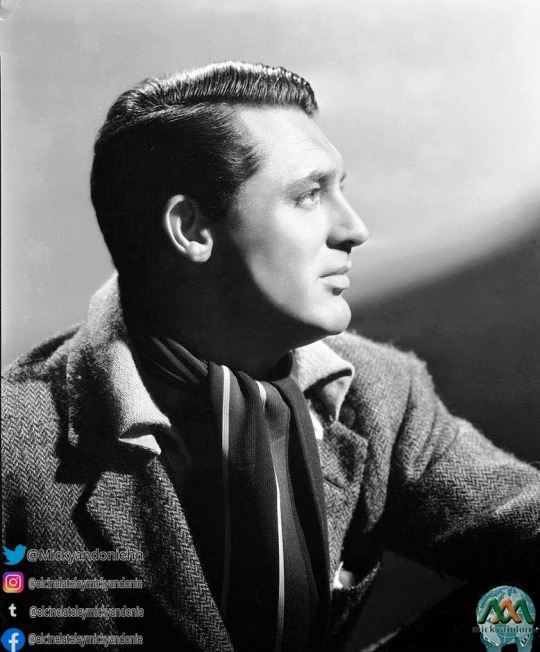




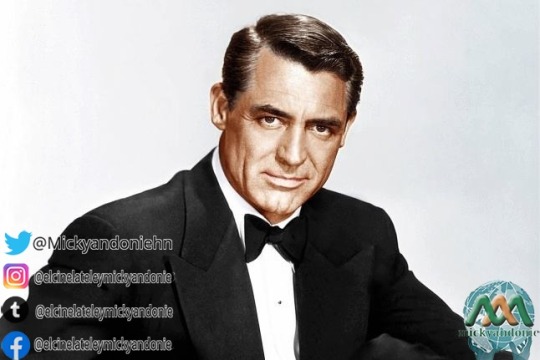

Cary Grant α:18 de enero 1904 Ω:29 de noviembre 1986
Cary Grant (nacido Archibald Alexander Leach, Bristol, 18 de enero de 1904 - Davenport, Iowa, 29 de noviembre de 1986) fue un actor de origen británico. Llegó a ser uno de los actores de Hollywood más populares durante décadas, no solo por su atractivo físico, sino también por su elegancia, su encanto y su agudeza. De él se decía que actuaba bien hasta de espaldas. Trabajó con muchas grandes divas del cine de Hollywood de su época: Marlene Dietrich, Mae West, Grace Kelly, Marilyn Monroe, Rita Hayworth, Katharine Hepburn, Sophia Loren, Joan Fontaine, Ingrid Bergman, Ginger Rogers, Doris Day, Deborah Kerr y Audrey Hepburn entre otras. El personaje de James Bond se inspira parcialmente en él. Según la lista del American Film Institute, está considerado la segunda estrella masculina más importante de los primeros cien años del cine estadounidense. Su verdadero nombre era Archibald Alexander Leach y nació en Bristol (Inglaterra). Grant tuvo una infancia infeliz y un tanto confusa. Su padre ingresó a su depresiva madre en un hospital psiquiátrico cuando su hijo tenía nueve años. Fue a la escuela en su ciudad natal, de la que fue expulsado a los 14 años (en 1918), tras un incidente relacionado con los vestuarios de las alumnas. Ese mismo año se incorporó a una compañía de teatro con la que llegó a Estados Unidos en 1920, y del vodevil en Broadway pasó a Hollywood en 1931. Es allí donde comenzó a utilizar el nombre de Cary Grant. Pronto consiguió papeles en películas de éxito, como La Venus rubia (1932, con Marlene Dietrich) y Lady Lou (1933, con Mae West). En 1942 adquirió la nacionalidad estadounidense. Grant protagonizó algunos clásicos de la comedia de enredo, como Historias de Filadelfia (1940) y La fiera de mi niña (1938), ambas junto a Katharine Hepburn, o Arsénico por compasión (1944). El director Alfred Hitchcock, cuyo desapego por los actores era notorio, se entusiasmó con Grant, y le contrató para actuar en cuatro de sus películas: Sospecha (1941; junto a Joan Fontaine), Encadenados (1946; con Ingrid Bergman), Atrapa a un ladrón (1955; con Grace Kelly) y Con la muerte en los talones (1959; junto a Eva Marie Saint), que se convirtieron en clásicos, al igual que otras obras del director. Aunque fue nominado dos veces para los Óscar, Grant no obtuvo el premio, si bien recibió en 1970 un premio especial de la Academia de Cine en reconocimiento a su carrera. En 1981 le fue concedido el Kennedy Center Honors en reconocimiento a su talento y contribución a las artes escénicas. Durante los últimos años de su vida, retirado del cine, fue ejecutivo de diversas empresas relacionadas con el mundo del cine. Se dedicó a viajar por el mundo y por Estados Unidos, donde realizó diversas sesiones de su programa Una noche con Cary Grant, en las que tras la proyección de fragmentos de sus películas, respondía a las preguntas del público. Grant se estaba preparando para una actuación en el Teatro Adler en Davenport, Iowa, en la tarde del 29 de noviembre de 1986, cuando sufrió una hemorragia cerebral (ya había sufrido previamente un ataque en octubre de 1984). Su esposa Barbara no sabía lo que estaba pasando y fue a una farmacia local para obtener una aspirina. Murió a las 11:22 pm en el Hospital de San Lucas en Davenport, Iowa, a la edad de 82 años, producto de las complicaciones de un derrame cerebral. La mayor parte de sus bienes, por valor de millones de dólares, fueron para su quinta esposa, Barbara Harris, y para su hija, Jennifer Grant.
FILMOGRAFIA
1932: This Is the Night (Esta es la noche).1932: Sinners in the Sun (Pecadores sin careta).1932: Merrily We Go to Hell (Tuya para siempre).1932: Devil and the Deep (Entre la espada y la pared).1932: Blonde Venus (La Venus rubia), de Josef von Sternberg.1932: Hot Saturday (Sábado de juerga).1932: Madame Butterfly.1933: She Done Him Wrong (Lady Lou (nacida para pecar)).1933: Woman Accused (La mujer acusada).1933: The Eagle and the Hawk (El águila y el halcón).1933: Gambling Ship (Casino del mar).1933: I’m No Angel (No soy ningún ángel).1933: Alice in Wonderland (Alicia en el país de las maravillas), de Norman Z. McLeod.1934: Thirty Day Princess (Princesa por un mes).1934: Born to Be Bad (Nacida para ser mala).1934: Kiss and Make Up (El templo de las hermosas).1934: Ladies Should Listen (Atención señoras).1935: Enter Madame (Mi marido se casa).1935: Wings in the Dark (Alas en la noche).1935: The Last Outpost (La última avanzada).1935: Sylvia Scarlett (La gran aventura de Silvia / Una muchacha sin importancia), de George Cukor.1936: Suzy (Suzy).1936: Wedding Present (Cásate conmigo... si puedes).1936: The Amazing Quest of Ernest Bliss (La maravillosa aventura de Ernest Bliss).1936: Big Brown Eyes (Sus grandes ojos marrones). Mr. Deeds goes to Town ("El secreto de vivir").1937: When You're in Love (Preludio de amor).1937: Topper (La pareja invisible se divierte).1937: The Toast of New York (El ídolo de Nueva York).1937: The Awful Truth (Terrible verdad / La pícara puritana), de Leo McCarey.1938: Bringing Up Baby (La adorable revoltosa / La fiera de mi niña), de Howard Hawks.1938: Holiday (Vivir para gozar / Negocios o placer), de George Cukor.1939: Gunga Din, de George Stevens (Gunga Din).1939: Only Angels Have Wings (Sólo los ángeles tienen alas), de Howard Hawks.1939: In Name Only (Dos mujeres y un amor).1940: His Girl Friday (Ayuno de amor / Luna nueva), de Howard Hawks.1940: My Favorite Wife (Mi mujer favorita), de Garson Kanin.1940: The Howards of Virginia (Pasión de libertad).1940: The Philadelphia Story (Historias de Filadelfia / Pecadora equivocada), de George Cukor.1941: Penny Serenade (Serenata nostálgica), de George Stevens.1941: Suspicion (La sospecha / Sospecha), de Alfred Hitchcock.1942: The Talk of the Town (Tres contra todos / El asunto del día).1942: Once Upon a Honeymoon (Hubo una luna de miel).1943: Mr. Lucky (Mr. Lucky).1943: Destination Tokyo (Destino Tokio).1944: Once Upon a Time (Érase una vez).1944: None But the Lonely Heart (Un corazón en peligro).1944: Arsenic and Old Lace (Arsénico y encaje antiguo / Arsénico por compasión), de Frank Capra.1946: Night and Day (Noche y día), de Michael Curtiz.1946: Notorious (Tuyo es mi corazón / Encadenados), de Alfred Hitchcock.1947: The bachelor and the bobby-soxer (El solterón y la adolescente / El solterón y la menor), de Irving Reis.1947: The Bishop's Wife (La esposa del obispo / La mujer del obispo).1948: Mr. Blandings Builds His Dream House (Los Blanding ya tienen casa), de H.C. Potter.1948: Every Girl Should Be Married (En busca de marido), de Don Hartman.1949: I Was a Male War Bride (La novia era él), de Howard Hawks.1950: Crisis (Crisis).1951: People Will Talk (La gente hablará / Murmullos en la ciudad).1952: Room for One More (Hogar, dulce hogar), de Norman Taurog.1952: Monkey Business (Joven otra vez / Vitaminas para el amor / Me siento rejuvenecer), de Howard Hawks.1953: Dream Wife (La mujer soñada), de Sidney Sheldon.1955: To catch a thief (Para atrapar al ladrón / Atrapa a un ladrón), de Alfred Hitchcock.1957: An Affair to Remember (Algo para recordar / Tú y yo), de Leo McCarey.1957: The pride and the passion (Orgullo y pasión), de Stanley Kramer.1957: Kiss Them for Me (El beso del adiós / Bésalas por mí), de Stanley Donen.1958: Indiscreet (Indiscreta), de Stanley Donen.1958: Houseboat (Hogar flotante / Cintia), de Melville Shavelson.1959: North by Northwest (Intriga internacional / Con la muerte en los talones), de Alfred Hitchcock.1959: Operation Petticoat (Operación faldas / Operación Pacífico / Sirenas y tiburones), de Blake Edwards.1960: The Grass Is Greener (Página en blanco), de Stanley Donen.1962: That Touch of Mink (Suave como el visón), de Delbert Mann.1963: Charada, de Stanley Donen.1964: Father Goose (Papá ganso / Operación Whisky), de Ralph Nelson.1966: Walk Don't Run (Camina, no corras / Apartamento para tres), de Charles Walters.
4 notes
·
View notes